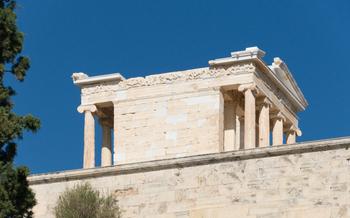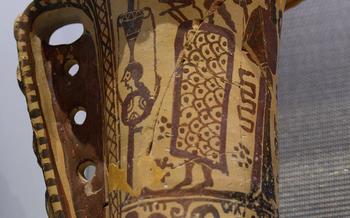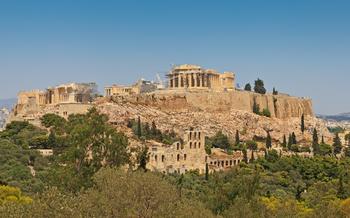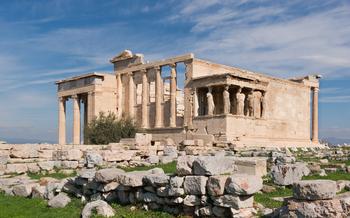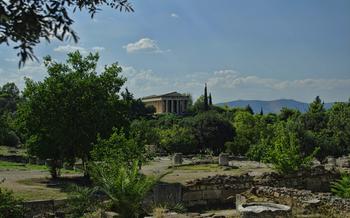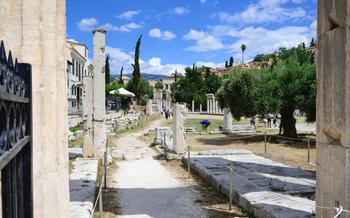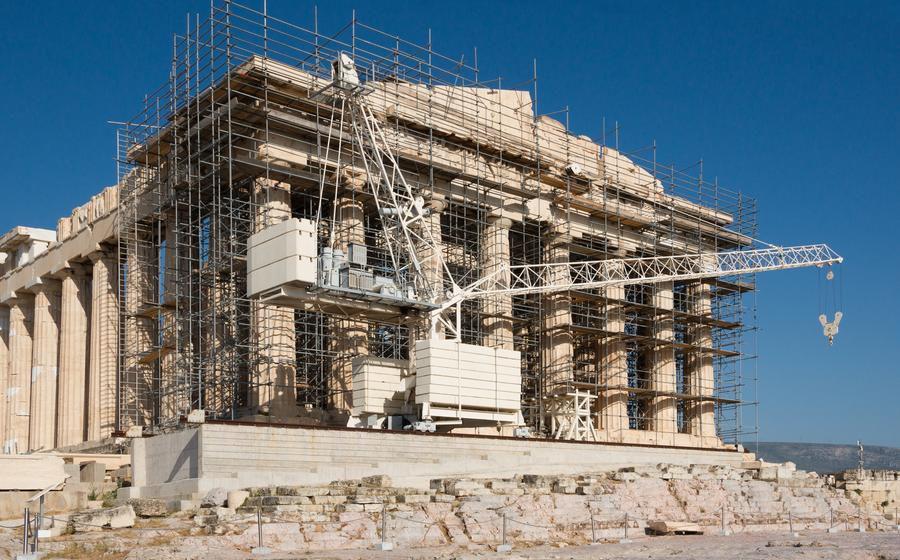
Parthenon
- Historical Significance
- Unique Features
- Location and Accessibility
- Tips for Planning a Visit
- Guided Tours and Audio Guides
- Exploring the Acropolis Museum
- Unveiling the Parthenon Marbles Debate
- Mythology and Legends
- Capturing the Perfect Shot
- Virtual Tours and Online Resources
- The Changing Colors of the Parthenon
- Preservation and Restoration Efforts
- Unforgettable Moments
- Insider Tip: Unveiling the Secrets of the Parthenon
Historical Significance
The Parthenon, an iconic symbol of ancient Greek architecture and culture, stands proudly atop the sacred Acropolis hill in Athens, Greece. Constructed between 447 and 438 BC during the Golden Age of Athens, this magnificent temple was dedicated to the goddess Athena, the patron deity of the city. Its construction was overseen by the renowned architects Iktinos and Kallikrates, who employed innovative architectural techniques and incorporated intricate sculptures that showcased the artistic prowess of the era. The Parthenon played a central role in ancient Athenian religious practices, serving as a treasury for the city's wealth and a venue for grand religious ceremonies, including the Panathenaic Festival, which celebrated Athena's birthday.
Unique Features
The Parthenon stands out for its distinctive Doric style, characterized by simple, horizontal lines and robust columns. These iconic columns, numbering 46 in total, are adorned with intricate fluting, creating a sense of rhythm and harmony. The Doric style, with its emphasis on strength and proportion, is a testament to the architectural prowess of the ancient Greeks.
Beyond its architectural features, the Parthenon is renowned for its intricate sculptures and pediments. The east pediment, facing the rising sun, depicts the birth of the goddess Athena, while the west pediment showcases the contest between Athena and Poseidon for the patronage of Athens. These sculptures, carved from Pentelic marble, showcase the exceptional artistry and craftsmanship of the ancient Greek sculptors.
The Parthenon Marbles, a collection of sculptures that once adorned the temple, hold a special place in art history. These exquisite sculptures, including the famous Elgin Marbles, are now housed in the British Museum in London, sparking an ongoing debate regarding their repatriation to Greece. The cultural and artistic significance of the Parthenon Marbles cannot be overstated, as they represent a priceless legacy of the ancient Greek civilization.
Location and Accessibility
The Parthenon stands majestically atop the sacred Acropolis hill, a rocky outcrop that overlooks the city of Athens. This prominent location, rising approximately 150 meters above sea level, offers breathtaking panoramic views of the cityscape. The Acropolis, with the Parthenon as its crowning jewel, is part of the UNESCO World Heritage Site, recognized for its exceptional cultural and historical significance. In proximity to other ancient landmarks, such as the Erechtheion, the Temple of Athena Nike, and the Propylaia, the Parthenon forms part of an architectural ensemble that showcases the grandeur of ancient Athenian civilization.
Tips for Planning a Visit
To make the most of your visit to the Parthenon, careful planning is essential. Consider visiting during the shoulder seasons (April-May and September-October) to avoid the summer crowds and enjoy pleasant weather. Advance booking of tickets online or through authorized tour operators is highly recommended, especially during peak tourist season, to secure priority access and skip long queues.
When visiting religious sites like the Parthenon, appropriate attire is expected. While shorts and tank tops are generally acceptable during hot weather, it's advisable to dress modestly and respectfully. Comfortable footwear is a must, as the Acropolis involves walking on uneven surfaces and climbing stairs. Remember to bring a hat, sunscreen, and water bottle to stay protected from the sun.
Guided Tours and Audio Guides
Enhance your visit to the Parthenon by joining a guided tour led by knowledgeable historians or archaeologists. These tours offer in-depth insights into the Parthenon's history, architectural significance, and religious importance. Explore the temple's intricate sculptures and learn about the stories and myths depicted on the pediments and metopes. Guided tours often include skip-the-line access, allowing you to bypass long queues and make the most of your time at the Acropolis.
For a more independent experience, consider renting an audio guide. Available in multiple languages, these devices provide a self-guided tour with detailed commentary on the Parthenon and other landmarks on the Acropolis. Audio guides offer flexibility and allow you to explore at your own pace, pausing to admire specific features or revisit sections that particularly interest you.
To make the most of your visit, consider booking a group tour or taking advantage of special tour packages that combine a visit to the Parthenon with other nearby attractions, such as the Acropolis Museum or the Ancient Agora. These packages often offer discounted rates and provide a comprehensive overview of ancient Athens.
Exploring the Acropolis Museum
Just a short stroll from the Parthenon, on the southeastern slope of the Acropolis, lies the Acropolis Museum, a treasure trove of artifacts and antiquities that once adorned the sacred hill. Step inside this modern architectural marvel, and you'll be greeted by an extensive collection of sculptures, inscriptions, and remnants from the Parthenon and other significant ancient structures.
The museum's exhibits are arranged chronologically, taking you on a journey through the artistic and cultural evolution of ancient Athens. Admire the intricate friezes that once graced the Parthenon's exterior, marvel at the colossal statues of gods and goddesses, and decipher ancient inscriptions that provide glimpses into the lives and beliefs of the Athenians.
Don't miss the Caryatid Porch, where six graceful female figures, known as Caryatids, once stood in place of columns, supporting the weight of the Erechtheion's roof. These iconic sculptures are a testament to the unparalleled artistry and craftsmanship of ancient Greek sculptors.
The Acropolis Museum is not just a repository of ancient artifacts; it's an immersive experience that brings the past to life. Interactive exhibits and multimedia presentations offer deeper insights into the history, mythology, and significance of the Parthenon and its sculptures.
For a truly comprehensive understanding of the Parthenon, a visit to the Acropolis Museum is an absolute must. Allow ample time to explore the exhibits, and don't forget to take advantage of the museum's audio guides, available in multiple languages, for a personalized and informative tour.
Unveiling the Parthenon Marbles Debate
The Parthenon Marbles, also known as the Elgin Marbles, hold a significant place in the ongoing debate surrounding cultural heritage and repatriation. In the early 19th century, Lord Elgin, the British Ambassador to the Ottoman Empire, oversaw the removal of numerous sculptures and architectural elements from the Parthenon and other ancient Greek temples. These marbles were subsequently transported to London and displayed in the British Museum.
The removal of the marbles sparked controversy, with many Greeks and international scholars advocating for their return to Greece. The Greek government has repeatedly called for the repatriation of the marbles, arguing that they are an integral part of Greece's cultural heritage and should be displayed in their original context.
The British Museum, on the other hand, has maintained that the marbles were legally acquired and are an important part of its collection. The museum argues that they have been well-preserved and are accessible to a wider audience in London than they would be in Greece.
The debate over the Parthenon Marbles is a complex one, involving issues of cultural ownership, colonialism, and the preservation of cultural heritage. The marbles represent a significant chapter in the history of Greece and their return remains a contentious issue.
Mythology and Legends
The Parthenon is deeply entwined with Greek mythology and legends, adding layers of intrigue and symbolism to its significance. According to Greek mythology, the Parthenon was built to honor the goddess Athena, the patron deity of Athens. The temple's sculptures and pediments depict scenes from Greek mythology, including the birth of Athena from the head of Zeus, her victory over the giants, and her rivalry with Poseidon for the patronage of Athens. These intricate carvings bring the ancient myths to life, providing a glimpse into the religious beliefs and storytelling traditions of ancient Greece.
One of the most famous myths associated with the Parthenon is the story of the Trojan War. According to legend, the Greeks built the Parthenon as a thank-offering to Athena for her assistance in their victory over the Trojans. The temple's sculptures include depictions of the Trojan War, including scenes of battle and the triumph of the Greeks. These mythological references add depth and meaning to the Parthenon, enriching the visitor's experience with a sense of awe and wonder.
Capturing the Perfect Shot
The Parthenon, with its majestic presence and architectural grandeur, presents a captivating subject for photographers of all levels. To capture stunning images of this iconic landmark, here are some tips to consider:
-
Golden Hour Magic: Aim to visit during the golden hours, just after sunrise or before sunset, when the warm, diffused light casts a magical glow on the Parthenon, enhancing its details and textures.
-
Multiple Perspectives: Explore different vantage points around the Acropolis to capture the Parthenon from various angles. Experiment with wide-angle shots to encompass the entire structure or zoom in for close-ups of intricate sculptures and architectural elements.
-
Panoramic Views: For breathtaking panoramic shots, head to the Areopagus Hill, Philopappos Hill, or the Pnyx, which offer elevated viewpoints overlooking the Acropolis and the city of Athens.
-
Symmetry and Composition: Utilize the Parthenon's symmetrical design to create visually appealing compositions. Experiment with leading lines, such as the columns or steps, to draw the viewer's eye towards the central focal point.
-
People and Scale: Include people in your shots to convey the scale and grandeur of the Parthenon. Position them strategically to create a sense of depth and perspective.
-
Respectful Photography: Remember to be mindful of other visitors and avoid using tripods or obstructing walkways. Follow the photography guidelines and regulations within the Acropolis to ensure a pleasant experience for everyone.
Virtual Tours and Online Resources
While visiting the Parthenon in person is an unforgettable experience, those unable to make the journey can still explore its wonders through virtual tours. Interactive platforms like Google Arts & Culture offer immersive 360-degree tours, allowing you to navigate the Parthenon's exterior and interior, zoom in on intricate details, and learn about its history.
Numerous online resources provide a wealth of information about the Parthenon. The official website of the Acropolis Museum offers detailed descriptions of the Parthenon's construction, sculptures, and restoration efforts, along with high-resolution images and virtual exhibits. Websites such as Ancient Greece.org and Perseus Digital Library provide comprehensive articles, historical texts, and images related to the Parthenon and ancient Greek culture.
Documentaries and videos offer another engaging way to delve deeper into the history and significance of the Parthenon. The BBC documentary "The Parthenon: A History in Stone" provides a fascinating exploration of the temple's construction, destruction, and subsequent restoration. The National Geographic documentary "Secrets of the Parthenon" takes viewers on a journey through the temple's architectural marvels and the stories behind its iconic sculptures.
The Changing Colors of the Parthenon
Over the centuries, the Parthenon has undergone a subtle transformation in appearance due to the effects of natural aging and weathering. The passage of time and exposure to the elements have resulted in a gradual shift in the color of the marble, evolving from its original gleaming white to a warm, honeyed hue. This transformation is particularly noticeable in the early morning and late afternoon light, when the sun's rays cast a golden glow on the Parthenon, creating a mesmerizing spectacle.
The changing colors of the Parthenon serve as a reminder of the building's enduring legacy and its ability to adapt and evolve gracefully over time. Just as the Parthenon's appearance has transformed, so too has its significance, evolving from a sacred temple in ancient times to a symbol of cultural heritage and a source of inspiration for generations to come.
Preservation and Restoration Efforts
The Parthenon, a testament to ancient Greek architectural prowess, has withstood the test of time for over two millennia. However, the ravages of nature, pollution, and human intervention have taken their toll. In response, preservation and restoration efforts have been ongoing for decades, aimed at ensuring the Parthenon's legacy endures for generations to come.
The Acropolis Restoration Service, a specialized team of experts, meticulously monitors the Parthenon's condition, employing cutting-edge technology to identify areas requiring intervention. Using traditional techniques, they carefully repair and reinforce damaged structures, employing materials that blend seamlessly with the original fabric of the building.
Balancing preservation with accessibility is a delicate task. While the Parthenon remains open to visitors, certain areas may be temporarily closed during restoration work. These closures, though necessary, can be frustrating for eager travelers. However, the long-term benefits of these efforts are undeniable, as they ensure the Parthenon's continued existence as a symbol of Greece's rich cultural heritage.
The preservation of the Parthenon is not merely a technical endeavor; it is a profound act of cultural stewardship. By safeguarding this architectural masterpiece, we honor the legacy of ancient Greece and preserve a tangible link to our shared human history. It is our collective responsibility to ensure that the Parthenon continues to inspire awe and wonder in visitors for centuries to come.
Unforgettable Moments
Visiting the Parthenon is an experience that stays with you long after you leave the Acropolis. The sheer size, intricate details, and historical significance of the temple create an awe-inspiring atmosphere that is difficult to forget. Whether you're a history buff, an architecture enthusiast, or simply someone who appreciates beauty, the Parthenon is sure to leave a lasting impression.
One of my most memorable moments at the Parthenon was watching the sunset over the temple. As the sun dipped below the horizon, the sky turned a brilliant shade of orange, casting a warm glow on the ancient ruins. The Parthenon seemed to come alive in the golden light, and I couldn't help but feel a sense of wonder and amazement.
Another unforgettable moment was when I stumbled upon a group of musicians playing traditional Greek music at the foot of the Acropolis. The haunting melodies and rhythmic beats filled the air, creating a magical atmosphere that transported me back in time. I sat down and listened to the music for hours, feeling completely at peace and in harmony with my surroundings.
The Parthenon is a place where history, culture, and beauty converge. It's a place that will stay with you long after you've left, and it's a place that you'll never forget.
Insider Tip: Unveiling the Secrets of the Parthenon
As you wander around the Acropolis, keep an eye out for the hidden gems that offer a unique perspective on the Parthenon. Venture beyond the main tourist paths to discover lesser-known spots that provide breathtaking views and a serene ambiance.
One such spot is the Dionysus Sanctuary, located on the south slope of the Acropolis. This ancient theater, dedicated to the god of wine and revelry, boasts stunning views of the Parthenon and the surrounding cityscape. As you sit in the stone seats, imagine the lively performances and rituals that once took place here.
Another hidden gem is the Areopagus, or Mars Hill, situated northwest of the Acropolis. This rocky outcrop served as a meeting place for the ancient Athenian court and offers panoramic views of the city, including the Parthenon. As you stand on this historic ground, let your mind wander back to the days when philosophers and statesmen debated issues of justice and governance.
To avoid the crowds and experience the Acropolis at a slower pace, consider visiting early in the morning or late in the afternoon. The golden light of sunrise and sunset casts a magical glow on the Parthenon, creating a serene and contemplative atmosphere.
Finally, impress your fellow travelers with this lesser-known fact: the Parthenon was not always white. Originally, it was adorned with vibrant colors, including blue, red, and gold. These colors have faded over time due to weathering and pollution, but traces of them can still be seen in certain areas of the temple.
Whether you seek hidden gems, stunning views, or lesser-known facts, the Acropolis and the Parthenon offer a treasure trove of secrets waiting to be discovered. Embrace the spirit of exploration and uncover the hidden wonders that make this ancient site so captivating.
